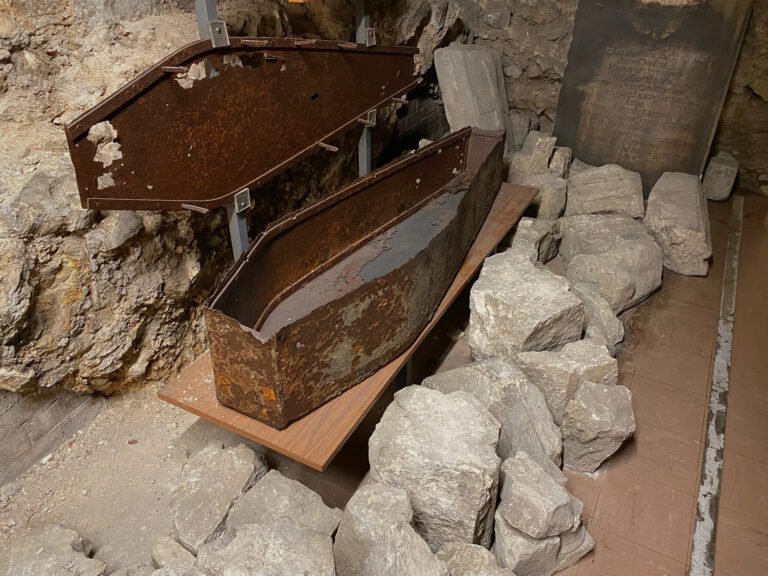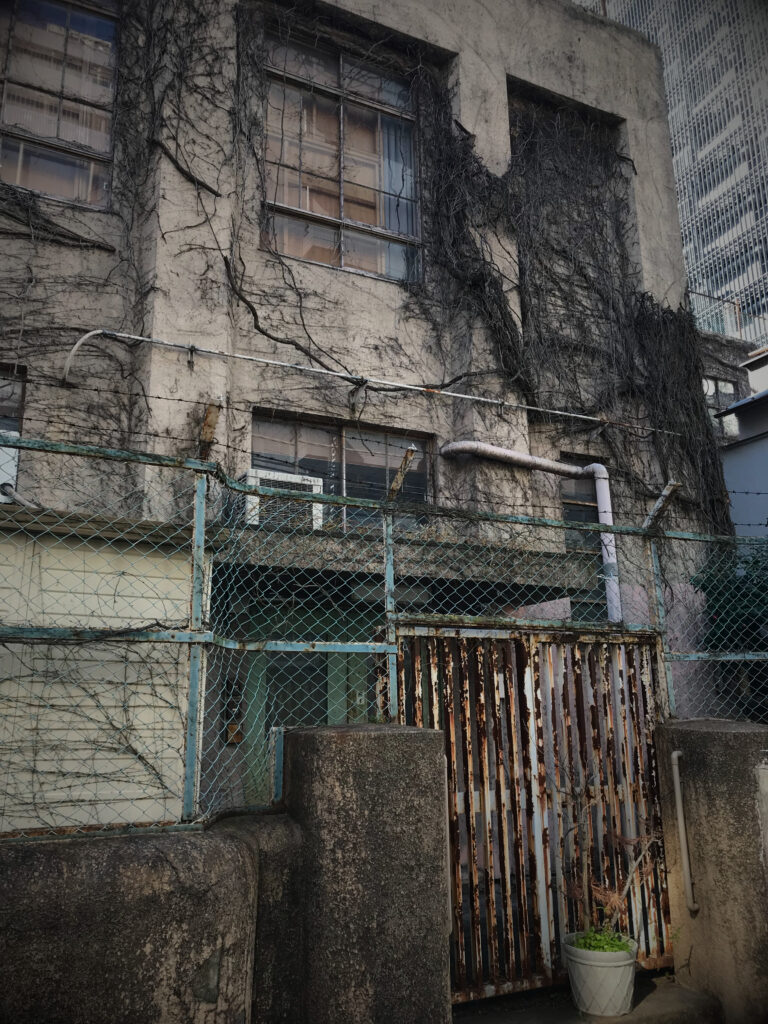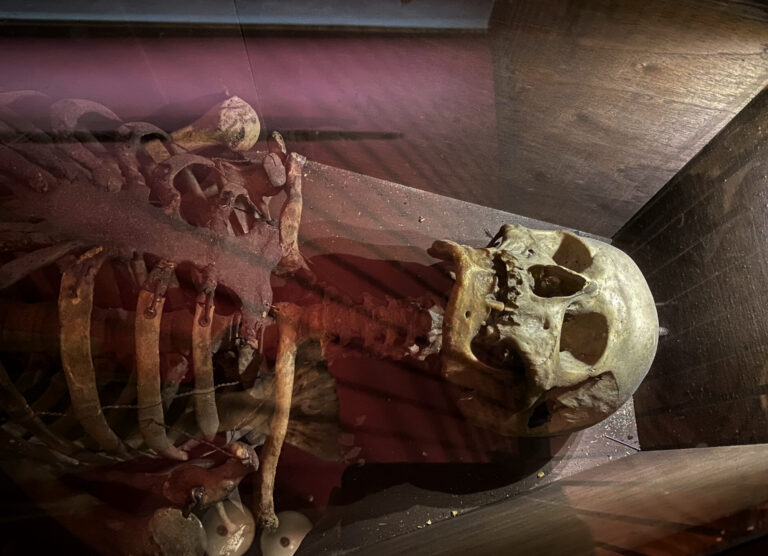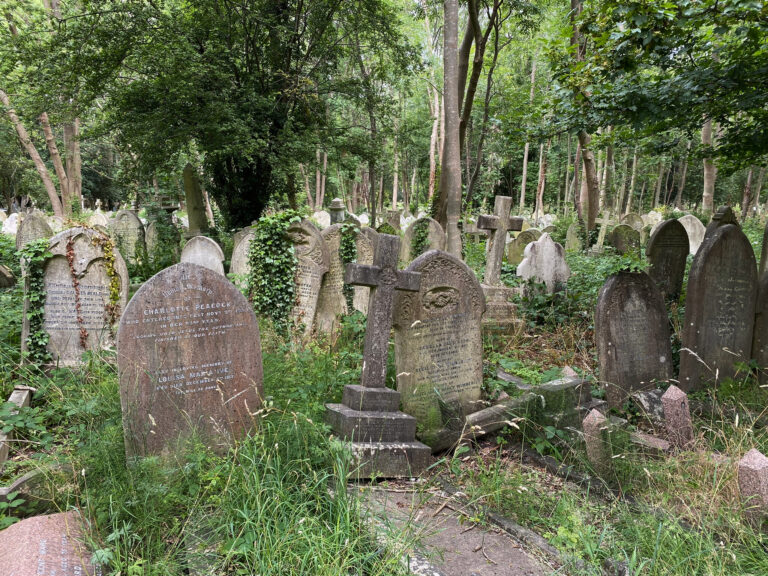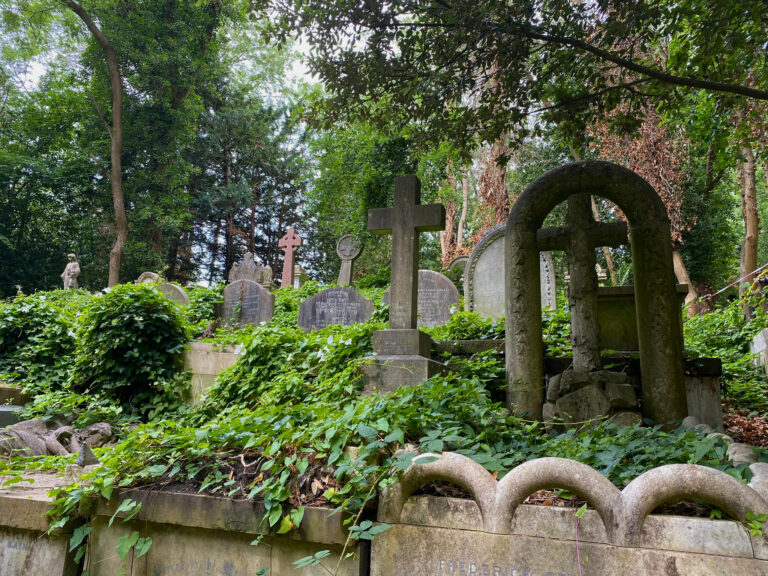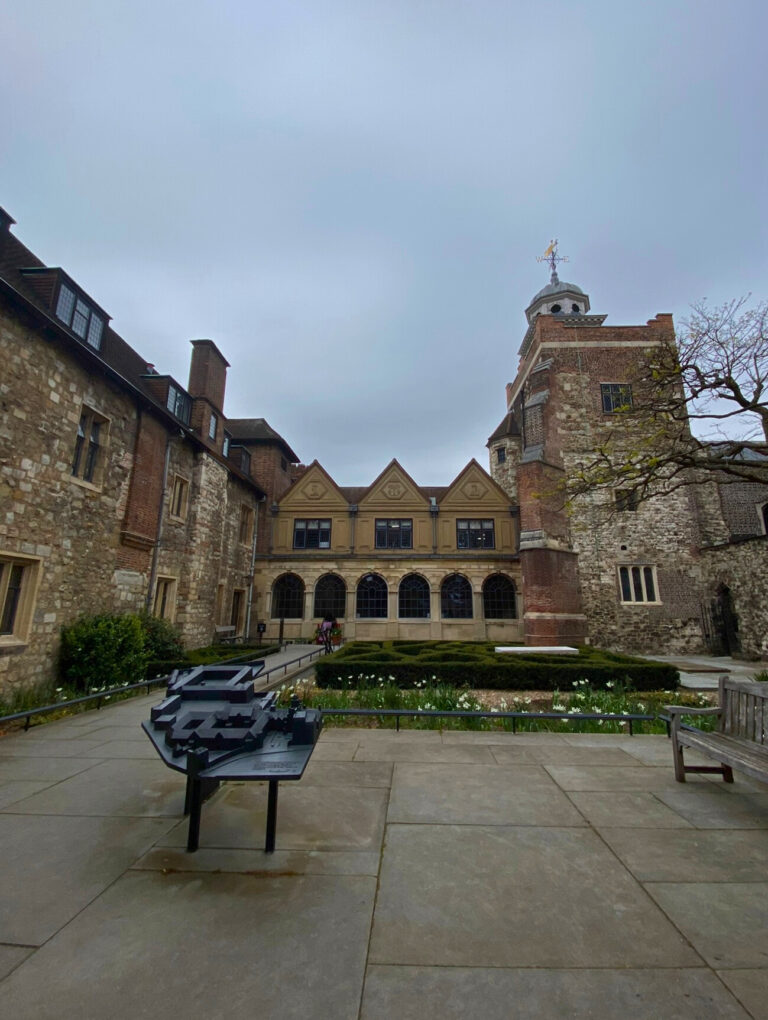- Yorkshire, England, United Kingdom19 August 2024
The Living Churchyard at
Bridlington Priory
I hadn’t meant to go to Bridlington churchyard. In fact, I found it quite accidentally. My mum and stepdad had invited me to join them on a trip to Scarborough – they knew I would never forgive them if they’d visited Whitby without me!
One morning we woke up and the weather was exceptional. Having already wandered quite a bit around Scarborough itself, we decided to drive to the nearby Bridlington, as we’d heard it was a nice little coastal town.
We had parked some way away from the seafront (“It’s cheaper!” Martin, my stepdad, had said adamantly), and we were walking towards the sea. As we passed by the Priory, I caught a glimpse of the churchyard then. I piped up that I wanted to stop by on the way back to the car, and that was that.
Woolly Jumpers & Pirates
It was early autumn when we went to Yorkshire, but Bridlington greeted us with an unseasonably sunny and warm day. We had a lovely day out walking down the big promenade that runs parallel to the beach. The sun sparkled off the sea as we explored the old sweet shop, ate an incredible ice cream (shout out to Jerome’s Café!), and tiptoed along the slick harbour walls.
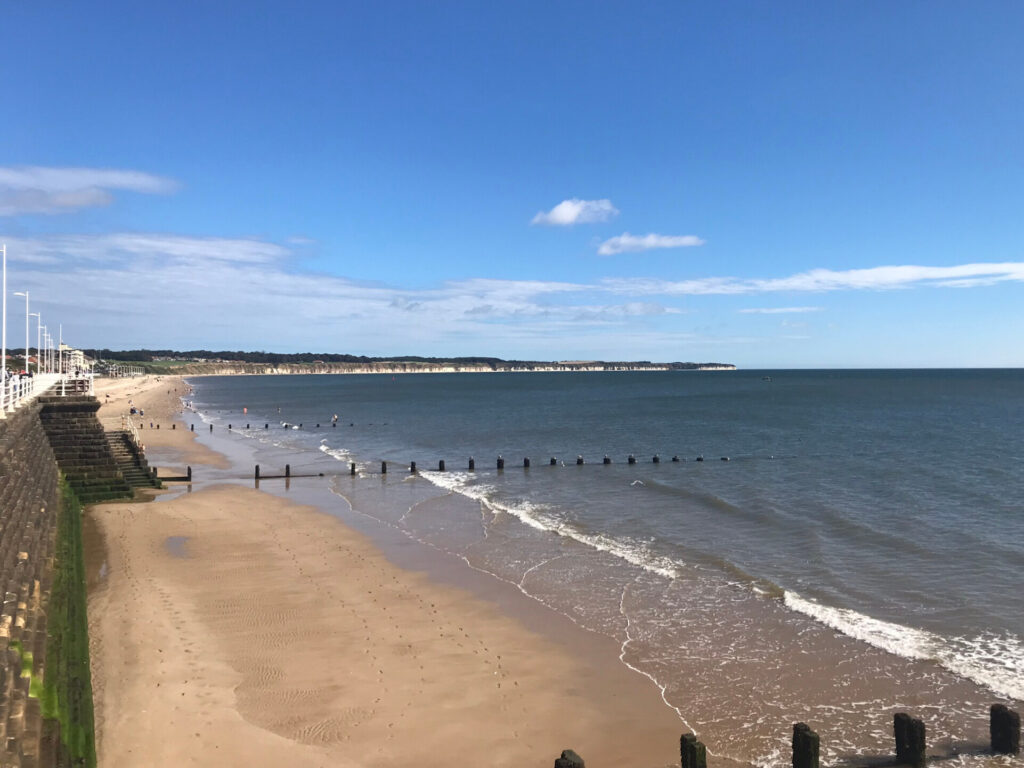
Immortalised Knitting
On one of the piers is a lovely statue of a ‘Gansey girl’. A Gansey, or guernsey, is a traditional style of fishing jumper that originates from the Channel Island of the same name. These jumpers were knitted by fishermen’s wives to protect them from the brutally cold British seas. They’re usually made of water-resistant wool and are thick, hard-wearing, and seamless, in naturally dyed colours.
Women eventually began to add their own motifs to their jumper patterns, so that their men would be identifiable if, heaven forbid, they got swept overboard. Different areas of the country have different knitting patterns for the Gansey, a bit like different Scottish clans having different tartans.
Anyway, the statue of the Gansey girl sits on the North pier in Bridlington so that fishermen can see her as they approach the harbour, and safety. She sits concentrating on the knitting in her lap, an air of loving worry and resigned calm about her. I loved her.
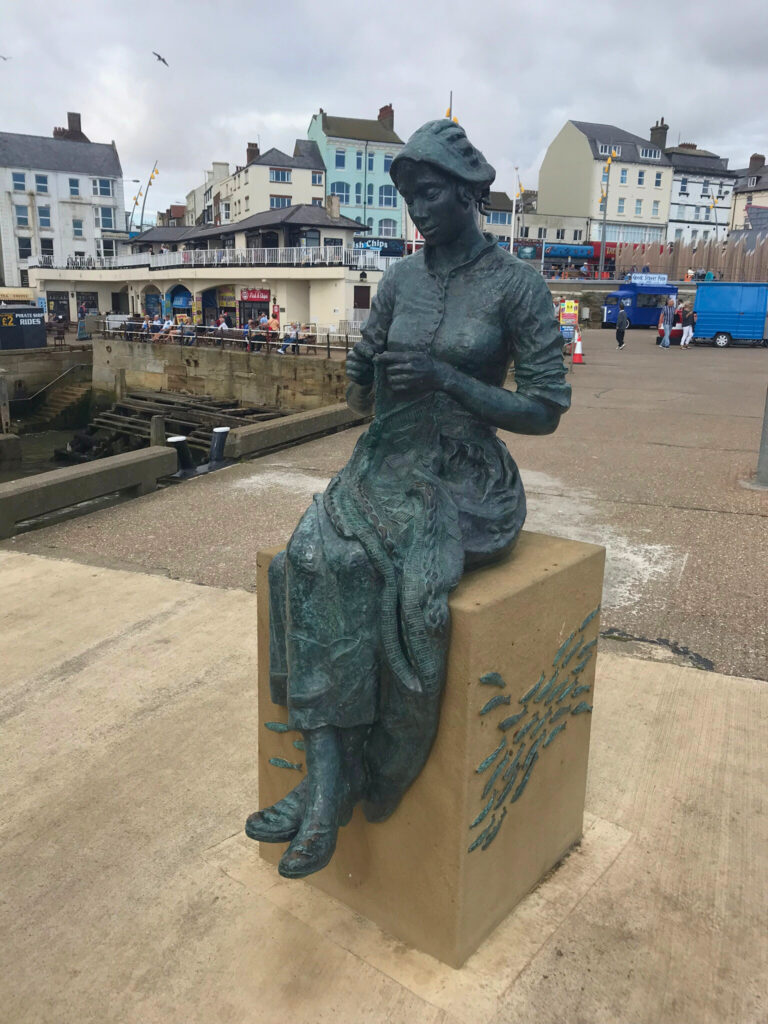
Pirates in Bridlington
It was a bit weird when we were walking on the pier and a pirate ship suddenly sailed by. I hoped it was the Flying Dutchman and that we were all In For It, but it wasn’t. It coasted up to a mooring site and we ambled over to see what was what.
Turns out, it was just a cute little boat ride – you could get on the pirate ship for a 10-minute sail for only two quid! I immediately became a child and wheedled that I wanted to ride the pirate ship, so on we clambered.
It was lovely to be out on the water. As it was such a nice day, the sea was calm, and we gently bobbed along with cool spray misting our faces. I sat facing the beach, watching it all go by. There weren’t loads of passengers on our ride, so it was pleasantly quiet and relaxed. A speedboat went hurtling by, the people inside waving and calling out to us – I love random, tiny human connections like that. It was so worth the £2 to have that fine, calm interval out on the sea.

Once we’d had our fill of Bridlington town, we ambled back towards the car. It was then that I remembered the intriguing churchyard I’d spied earlier.
A Local Historian
Officially, the name of the church is the Priory Church of St Mary. It sits on a church green right beside the darling Old Town of Bridlington, which is all crooked rows of old buildings and indie businesses (including a very nice bakery). The church itself is beautiful and much larger than I’d originally thought.
As we walked into the graveyard, we noticed a man on a ladder doing some work on the church wall. He was being watched by an older woman who we assumed was part of the Priory in some way. She greeted us warmly and let us know that the church itself was unfortunately closed that day, but that we were very welcome to spend time in the grounds.
She asked if we’d been there before, then proceeded to give us a quick history lesson about the place.

Basically, the Priory building you see today is much smaller than it used to be. There used to be a whole campus there including dormitories, a tower, cloisters, and everyday things like a bakehouse and a treasury. Here’s a wonderful map of how that was laid out:
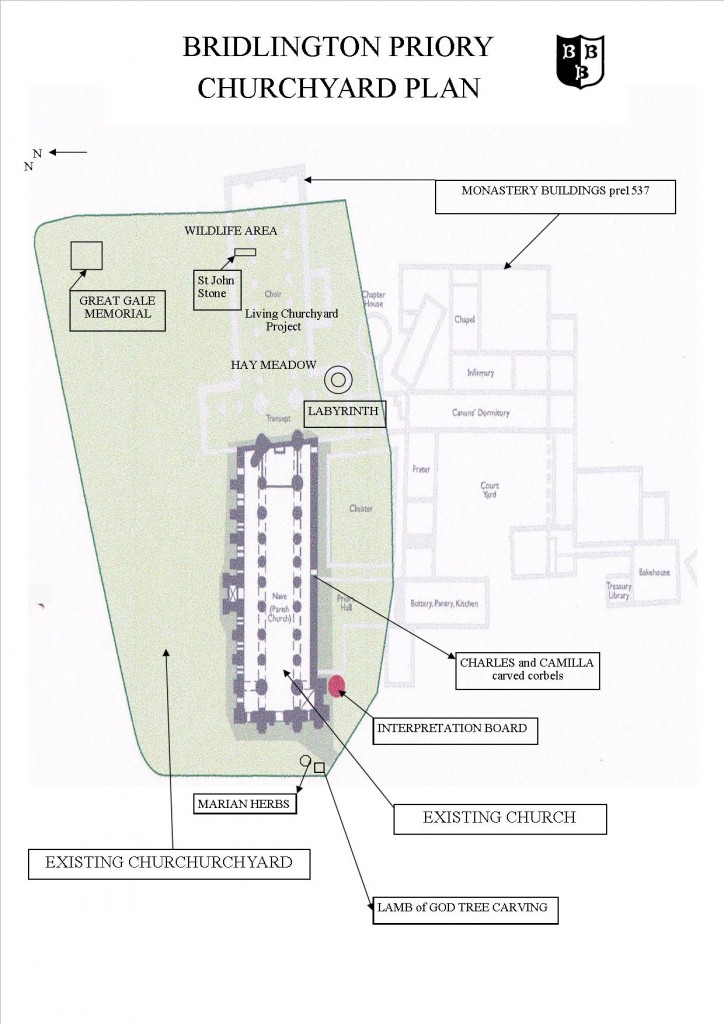
© Bridlington Priory
The actual Priory was established in the early 12th century, and it was almost certainly built on the site of a church that had existed since at least the Domesday Survey in 1086. So this place is old old.
In 1539, everything except the nave (the part you see today) was destroyed because of – you guessed it!! – Henry VIII and his crusade against the Catholic church. They also burned the original shrine of St John, which is just rude.
Last Man Standing
William Woode, the last Prior of Bridlington, was hanged for treason at Tyburn for his support of the Pilgrimage of Grace. Despite its gentle name, the Pilgrimage was a huge revolt against His Maj. the Eighth.
Beginning right there in Yorkshire, there were many reasons for the revolt. The one Prior Woode supported was of course the religious upheaval and sacking of lesser monasteries. I imagine the Pilgrimage was a bid to save the more prominent priories, including Bridlington. Unfortunately, we all know how that turned out.

Bridlington Priory remained in disrepair until restoration efforts began in the 19th century. Ever since then, it has stood firmly in place, even escaping World War Two with just one blown-out window!
Obviously, I’ve condensed the history a lot here. As the original site has been in use for almost a thousand years, there’s an abundance of backstory! If you’re hankering for more history, there’s plenty more to read on the Priory’s website.
It was so interesting to listen to, and I’m forever amazed at these pockets of history just being everywhere in the UK. You don’t even have to look that hard to find them. I wish I’d gotten History Lady’s name; her information was invaluable and set a perfect springboard for my own research.
The Living Churchyard
The current churchyard at the Priory is a nice idea. To survey wildlife and conserve the area, the Diocese of York teamed up with the Yorkshire Wildlife Trust to create a ‘living churchyard’. Essentially, they let the local grasses and wildflowers grow all over the place. In turn, this encourages flora and fauna to stay in the habitat. The local plants benefit important pollinators like bats and bees, as well as enticing birds and insects of all kinds to hang out there.

In addition, they’ve made various hides for local critters including a stone pile, wood pile, and compost heap. Imagining all the little hedgehoggies nestling in the wood makes me so happy!
The hay meadow is only mowed twice a year, in April and October, and all cuttings are removed to encourage the local grass and wildflowers to regrow. Other than those two mowings, the meadow is left to do what it wants, and the effect is wild, beautiful, and oddly spiritual.
I really enjoyed the overall look the living churchyard has. It’s overgrown but by no means neglected. Among the dead, life bursts out everywhere you look. There is real beauty, peace, and power there.

Labyrinth of the Dead
My favourite part of the churchyard was the labyrinth. It was ‘drawn’ on the floor in narrow gravel paths. At the beginning was a pot full of stones. The idea is that you take a stone, which represents a burden you’re carrying or grief for a dead loved one. Take a second to physically feel the smoothness of the stone, the physical weight of the lump in your throat.
Then, walk with your stone to the centre of the labyrinth. There are lots of ways to get to the middle, and you have to follow your heart rather than taking any specific route. I found myself looking down at my feet and letting the path take me.

When you reach the centre, you will find a blue pot similar to the one you collected your stone from. This is where you lay your stone, your grief, down. This is the physical act of unloading a burden, or leaving your deceased loved one in the hands of God.
I was immensely touched by this lovely idea, and I imagine a lot of people get some spiritual calm from doing it. Have you ever come across a ‘labyrinth’ like this? Tell me in the comments! I’d never seen anything like it until I visited the Bridlington churchyard.
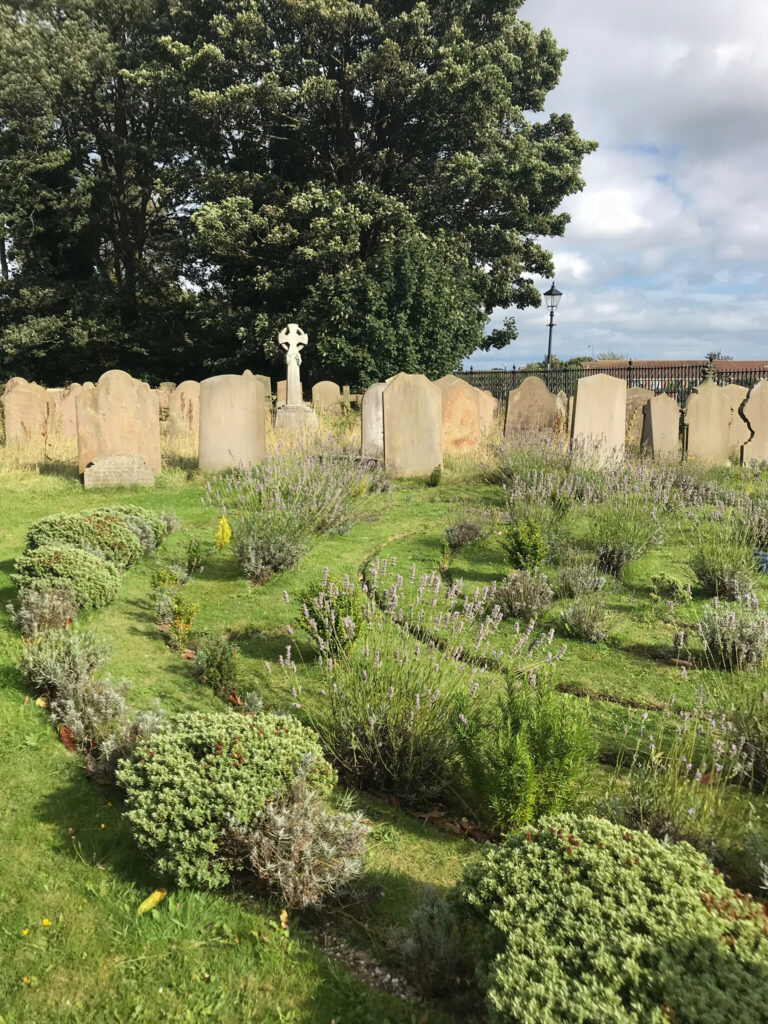
The Last Saint of Bridlington
Bridlington churchyard is also home to a shrine for St. John of Bridlington. John of Thwing died of the plague in 1379 and was the last saint to be canonised (in 1401) before King Harry’s monastery mayhem. (seriously, why does this keep coming up!?)
He (John, not Henry the Eighth) was said to perform many miracles, the frequency of which only increased after his death. His shrine at Bridlington was a pilgrimage site said to be as popular as that of the martyr Thomas Becket.
Obviously, the original shrine didn’t escape the wrath of the Reformation. Today, there’s a new standing stone with his name on it, as well as a ledger stone made by artist Stephen Carvill, who has one of the best examples of an aptronym I’ve seen. (Fun fact: Mr. Carvill also carved – Carvilled? – the Gansey girl statue I talked about earlier) Written on the ledger stone is:
O Prior Bridlyngtonie pie, Imitator caste vie, Representa nos messye.
This translates to ‘O Holy Prior of Bridlington, follower of a chaste life, pray for us’. We wouldn’t have known about the shrine or where to look for it if it weren’t for our impromptu history lesson earlier. Even then, it took a bit of hunting in the long, swaying grass. It was really special to find St John and see the memorial for ourselves.
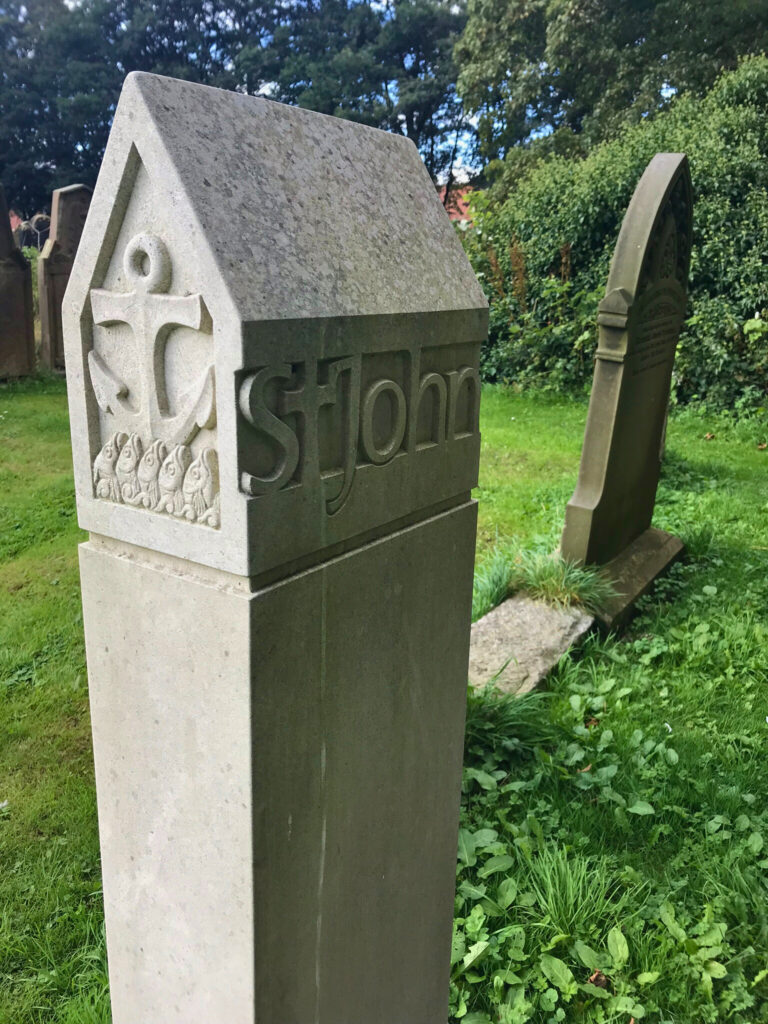
Fisherman’s Sorrow
If you continue walking north from the shrine, you soon come to a large obelisk. The ground around it is free from headstones, as there is a mass grave beneath. Surprisingly, as our friend St John might’ve led you believe, this isn’t a plague pit.
The monument commemorates the victims of the Great Gale of 1871. As always, us Brits show a talent for understatement, as the ‘gale’ was actually a huge storm which caused tumultuous seas. All told, it claimed 30 ships and at least 50 lives. It was a devastating loss for Bridlington and the towns around it (I spotted ships that came from Scarborough and Whitby, amongst others).
Every year, the Priory and the Bridlington RNLI hold a remembrance ceremony for those who died and for the heroic rescuers that went to the ships’ aid.

We learned from our history lady that this storm was used as evidence by Samuel Plimsoll (I can suddenly smell the rubber of my school P.E. daps…) to demonstrate how overloading ships can make an already dangerous situation into something far more tragic. His campaigning pushed the government into creating regulation for cargo limits using a ‘Plimsoll line’, which is still used on ships to this day! Up Sam Plimsoll!
Browsing Graves
We spent a long while walking along the lines of gravestones on the northern boundary of the site. That time was spent reading names and epitaphs and admiring the decorations and flowers that people had left.
In this part of Bridlington churchyard, I felt peaceful and a little sad. When in any burial ground, I like to pay attention to as many graves as I can. Just out of respect, you know… I am crashing their resting place, after all.
On our way back towards the gate, I was admiring the Priory door (I have thing about interesting doors) when my eyes travelled upward to strange gaps in the wall. There appeared to be plinths waiting for statues to be placed on them.
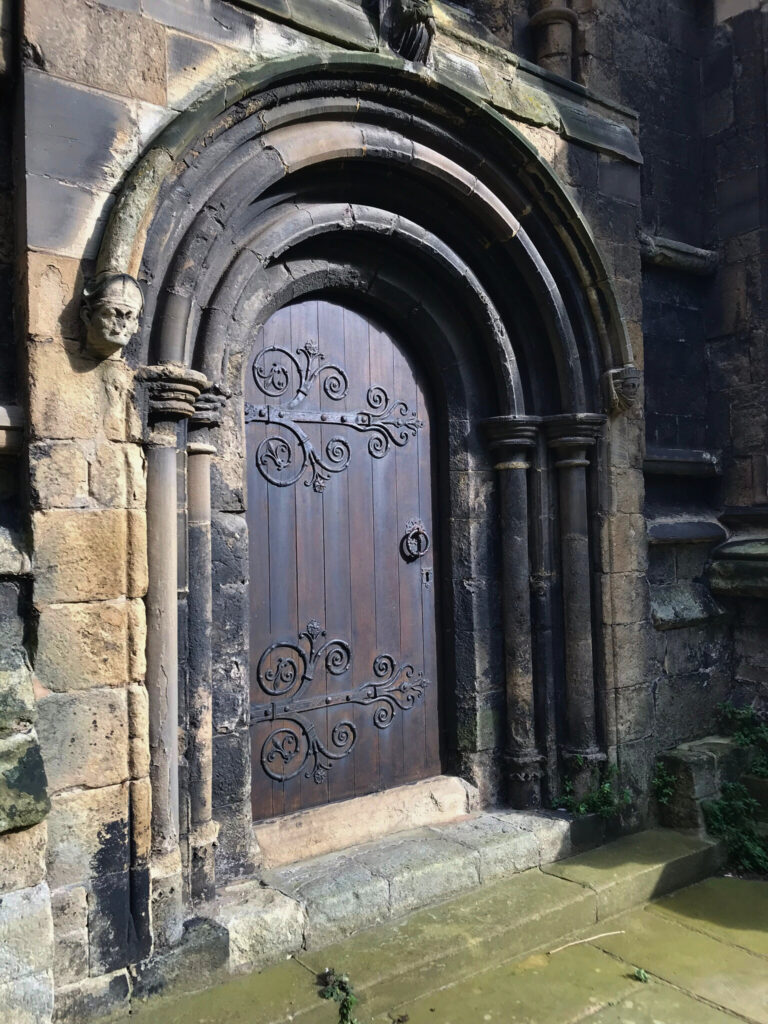
I guessed that there had been figures of saints there, pre-Dissolution. During my research later, I confirmed it. Damn, Henry. Those empty stands, where the saints once stood, were so eerie.

Wooden Lamb
There’s a wonderful carved tree at the southwest gate that I loved. The carving is of a ‘lamb of God’ and was created by our old pal Stephen Carvill in 2013, to mark the 900-year(!!) celebration of the Priory. It includes the Bible quote “Behold the Lamb of God who takes away the sin of the world.” (John 1:29).
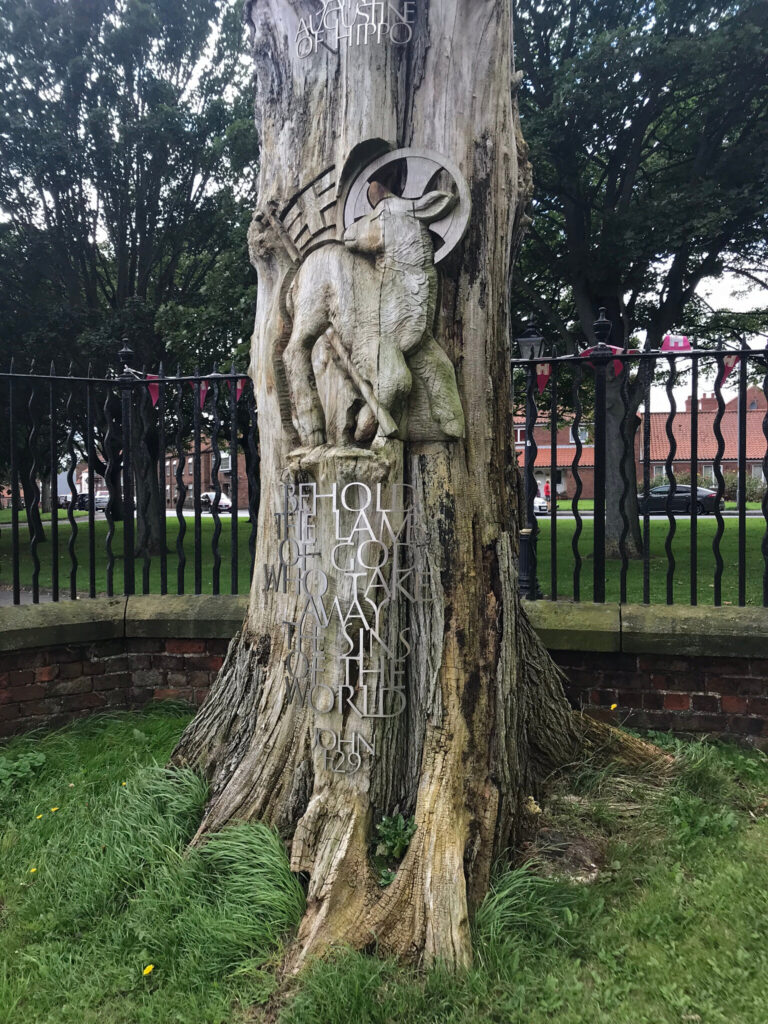
You can see the Bible quote beneath the lamb in my photo, but you can’t see what’s written above it. It’s that wonderful quote from Saint Augustine of Hippo:
There is no saint without a past
and no sinner without a future.
Bridlington churchyard really was something else. The whole place has such a nice aesthetic. You all know I love a graveyard anyway, but this one was truly unique, natural, and so beautiful.
If you’re ever up that way (East Yorkshire), definitely go and have a look for yourself. It doesn’t matter when you go – I imagine it looks totally different with each season, so it’ll always be a pretty surprise. However, avoid April and October if you want to see the living churchyard at it’s most wild.
The churchyard is also incredibly peaceful. The site isn’t at all isolated from the town, but the yard itself is so quiet and calm anyway. You can’t help but feel relaxed and reflective.

Mostly, though, I’m bowled over by how much history and cultural impact (the Plimsoll line!?) is hiding in this unassuming little churchyard, in this unassuming little seaside town. So many places are hiding these incredible stories, and we often walk right past. I’m glad I insisted on stopping there, despite not knowing anything about it and just liking the look of the churchyard.
Visiting Bridlington Priory
Whenever I make it back to East Yorkshire, I’d like to go back and see the inside of Bridlington Priory too. My interest has been piqued by their lovely, lovely churchyard (did I mention that it’s LOVELY??). Admission to the church is free, and I’m now armed with the opening times too. Monday-Friday from 11am-3pm and 10-12 on Saturdays. Sunday services are at 8am, 10:30am, and 6:30pm – with the latter two having choir performances.
Aside from being a religious sanctum, Bridlington Priory appears to be an amazing community space. There’s a whole host of events like a cake and coffee stall, chat & crafts, the ladies’ group, and a walking group. They even have bell-ringing practice! Any budding campanologist can go along and learn the ropes (literally). I also like the idea of Messy Church – once a month, kids and adults can come and flex their creative muscles with God-themed craft.
I was touched to read about the church’s Listening Ear service. Basically, anyone can contact them if they need emotional support, or just someone to talk to. It seems Bridlington Priory hasn’t forgotten Big J’s original message – to love one another and to help whenever you can.
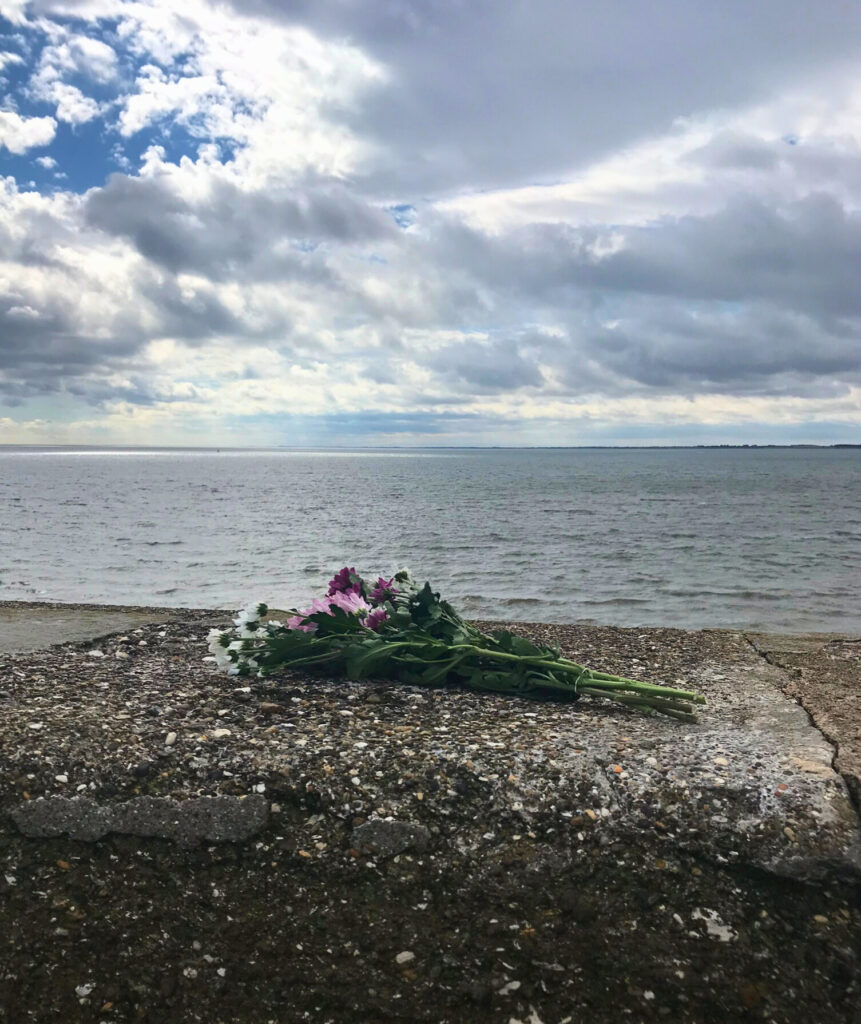
The church regularly has interesting exhibitions, too. The next one runs from August 24 to September 7 and is called ‘Christian and Cultural Heritage’. It’s being run by the Bridlington Art Society in celebration of their 75th anniversary.
Bridlington Priory is also a member of the Anglican Society for the Welfare of Animals, and has ‘animal-friendly church’ status. (I mean, dog is god backwards so…) The Priory website amusingly maintains that dogs and well-behaved owners are permitted.
~~
While researching this post, I found out that the church is one of the many causes on Easy Fundraising. EF is a site where loads of online shops have pledged to donate a portion of sales to the causes their customers choose.
I’d never heard of it before, but so many brands are involved in it and the causes represented are endless. The customer doesn’t have to pay more money or do anything except click an extra link when checking out. Just shopping will donate the cash. We truly live in the future!
I’ve currently set my own EF account to donate to the Bridlington Living Churchyard. No extra money or real effort, but I get to keep a 900+ year old slice of history alive? Yes please!
Have you been to a churchyard that resonated with you like Bridlington did me? Please tell me all about it in the comments, I’m forever looking for more burial grounds!

- Filed under:Graveyards & Burial Sites///History


